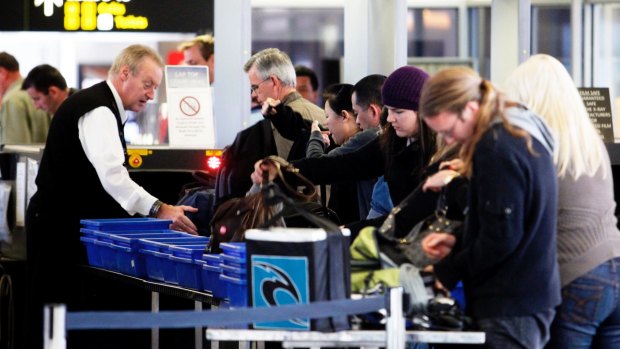This was published 4 years ago
No more removing laptops, liquids and gels from carry-on bags at Melbourne Airport as new scanners roll out
By Michael Fowler

Travellers flying from Melbourne Airport's Terminal 4 will no longer have to remove laptops, liquids or gels from their carry-on bags when passing through security.Credit: Paul Rovere
Many travellers at Melbourne Airport will no longer have to remove laptops from their carry-on bags when passing through security, with Australian-first 3D scanning technology permanently installed on Thursday.
The full-time introduction of four "smart lanes" in Terminal 4, the $400 million budget airline terminal opened in 2015, follows a successful trial last year and aims to cut average waiting time by 50 per cent to about one minute.
Other improvements include advanced explosive detection, drastically reducing the number of manual explosive checks, and automated tray return that removes bottlenecks.
The scanners will roll out to the international terminal, Terminal 2, over the next two months, meaning passengers flying overseas will no longer need to remove their laptops or liquids and gels when passing through security as the festive season nears.
Scott Dullard, head of security and emergency at Melbourne Airport, said the "smart lanes" improve on existing two-dimensional imaging by implementing three-dimensional CT scanning similar to that used in medicine.
"The introduction of CT Technology at screening checkpoints is a great example of technology enabling two strategic focus areas for Melbourne Airport: security outcomes and passenger experience," he said.
"The new technology allows analysis of 3D images, improving security outcomes by providing security staff with greater detail, and functionality to conduct their assessments."
Mr Dullard said Terminal 4 would be able to process 3000 people per hour at peak times, up from 2000.
See also: Australia has the second busiest flight route in the world
Melbourne's Terminal 4, which primarily serves domestic Jetstar, Tiger, Virgin Australia and Regional Express (REX) flights, and Terminal 2 will receive a further two and seven smart lanes respectively within the next two months.
"That should cover around 90 per cent of our traffic over the Christmas period, before we achieve 100 per cent compliance next year," said Mr Dullard.
The Melbourne-Sydney air corridor is the world's second-busiest. Melbourne Airport data predicts the number of people passing through Melbourne will increase from 35 million this year to about 64 million in 2033.
Where laptops once worked as a flat shield from other items in 2D images of bags, CT scanning allows security workers to look "through" the laptop and rotate how the bag appears on their screen.
Improved explosive detection means random manual explosive checks of passengers will consequently almost disappear, which Mr Dullard said had drawn most positive feedback from passengers along with the laptop change.
"We had someone as recently as yesterday do a fist pump when we told him he didn't need to take his laptop out of the bag ... we've also had a few people with implants that are very happy to hear the process no longer results in them alarming," he said.
Melbourne Airport says a new software platform will also reduce operational costs.
Jordan Thrupp, managing director of Smiths Detection who developed the smart lanes, said it was too early to know whether this would result in job losses but early evidence indicated workers would be redeployed in different roles, rather than let go.
Mr Dullard said Melbourne Airport, part of an international smart security group together with airports including London's Heathrow, Singapore's Changi and the Netherlands' Schiphol, was the first airport in Australia to introduce the smart lanes because "we pride ourselves on embracing change and technology".
The one-year trial had resulted in changes such as a shift to touch screens for operators, Mr Dullard said.
Other Australian airports are expected to install the improved technology in the next two years, in line with tightened federal government regulations.
"We look forward to continuing to work with airports across Australia to ensure security compliance, particularly as the Australian government continues to enhance the aviation security screening regulations," said Mr Thrupp.
See also: US airport security trashed my bag and then taped it back together
See also: Flight forced to land after passenger gets stuck in toilet
Sign up for the Traveller Deals newsletter
Get exclusive travel deals delivered straight to your inbox. Sign up now.